Two Young Girls Died While Subway Surfing in New York City — What Is It?
"I’m sorry for how our friendship ended, you will always be one of my best friends."
Published Oct. 8 2025, 1:36 p.m. ET

The first underground line of the New York City Subway opened in October 1904. Since then, there have been enough incidents connected to the impressive rail system to warrant several Wikipedia pages. Some are dedicated to accidents, while others list the various subway-related crimes. For example, in October 1965, 28-year-old Arthur Collins was murdered in front of his wife and child after defending passengers from a belligerent, intoxicated man. The list goes on.
With over 665 mainline track miles, it makes sense that a lot of things can go wrong, unchecked, or simply unnoticed. Sixty years after Collins died while protecting his fellow passengers, the bodies of two teenagers were discovered on top of an incoming J train at the Marcy Avenue stop in Brooklyn on the morning of Oct. 4, 2025. Authorities say they were subway surfing. Here's what we know about it.
What is subway surfing?
Subway surfing, or train surfing, is not a new phenomenon and didn't get its start in New York City. It's exactly as it sounds. People hop on the outside of a train or other railcar either to avoid paying, because it's crowded, or as a form of entertainment. According to PBS, homeless people were frequent train hoppers during the Great Depression. At its height, more than 250,000 teenagers traveled around America via an illegal train ride.
In the documentary Riding the Rails, producers Michael Uys and Lexy Lovell placed ads in newspapers in the hopes of finding former rail riders who risked death in order to keep living. They heard from about 3,000 people who were in their 70s and 80s, who wanted to relive that time, for better or worse. "Some hadn't spoken of their experiences in sixty years," said Ulys. "They were just kids then and when they look back, it's with a blend of nostalgia and pain."
Most if not all of the people who reached out to Ulys and Lovell were teenagers at the time. Some were escaping abusive homes. Others were looking for work. A few were dazzled by stories of cowboys or life in the big city they previously discovered in motion pictures. James San Jule was 17 when he left Oklahoma and hopped on a train to New York City. "I lived down in a subway kiosk for four months," he recalled, stealing food to survive. Sadly, the subway and subway surfing can be extremely dangerous.
What happened to Zemfira Mukhtarov and Ebba Morina?
Decades after the Great Depression ended, train hopping turned into subway surfing, which is a prank or stunt of sorts. According to the New York Post, as of October 2025, there have been five deaths in 2025 related to subway surfing. In the early morning hours of Oct. 4, police were called to Marcy Avenue-Broadway subway station in Williamsburg following reports of two unconscious girls on top of the Brooklyn-bound J train.
They were later identified as 12-year-old Zemfira Mukhtarov and 13-year-old Ebba Morina. Mukhtarov’s mother told The Post that her daughter was a thrill-seeker obsessed with dangerous stunts. Her parents were constantly pleading with Mukhtarov to stop. The 12-year-old's TikTok was filled with similarly dangerous acts, such as walking along a narrow beam while a subway zipped by beneath her.
Less is known about Morina, whom Mukhtarov's mother says she did not know. The grieving mother theorizes the two likely met online. Messages in an obituary for Morina show the 13-year-old was loved and will be missed. "Ebba I hope you are happy in heaven," wrote one person. "I’m sorry for how our friendship ended, you will always be one of my best friends."
Warnings about subway surfing are on the official website for the New York City government. They implemented a Subway Surfing Kills – Ride Inside, Stay Alive campaign that is a "targeted response to the increase in subway surfing incidents that have claimed the lives of several youth in our city."
